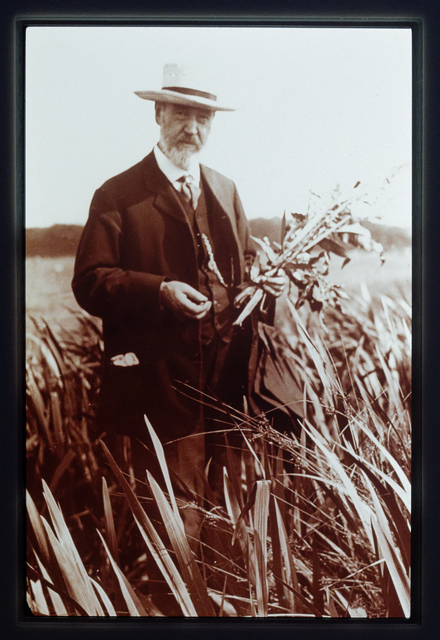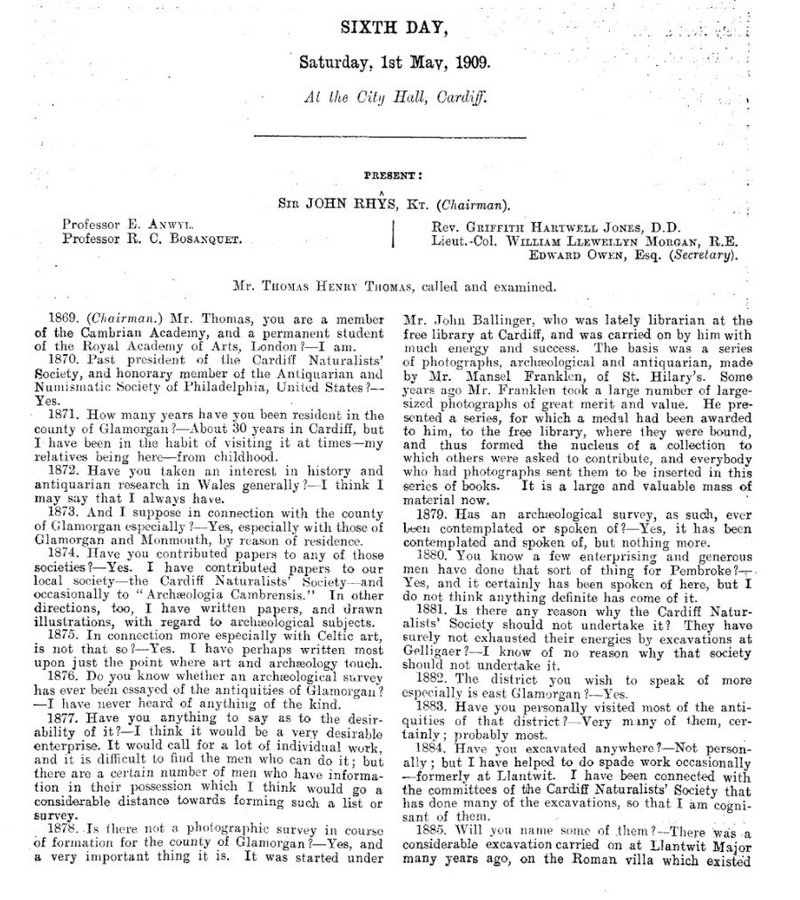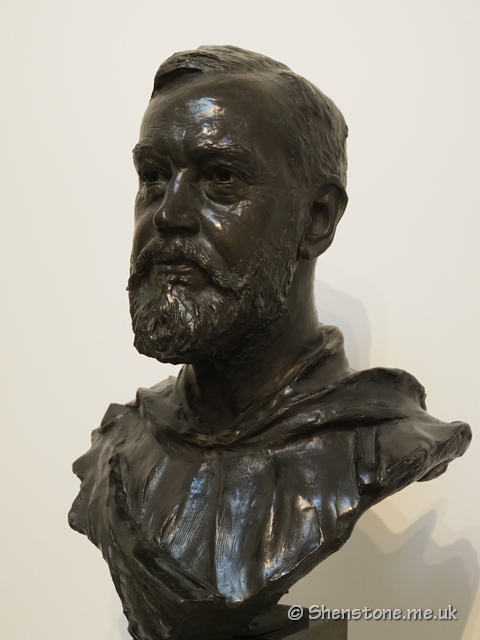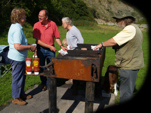
Cardiff
Naturalists' Society
Cymdeithas Naturiaethwyr
Caerdydd
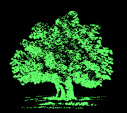
Thomas Henry Thomas, R.C.A. (1839-1915) 16th President
|
Back to the 150th Anniversary index Thomas Henry Thomas was an artist and antiquarian with a keen interest in geology, biology, botany, archaeology and folklore. He became the first Herald Bard of the Eisteddfod Gorsedd in 1895 and was responsible for much of the modern pageantry and ritual associated with the Eisteddfod. He was influential in the founding of the National Museum of Wales and had a special interest in the Welsh art collections. He was involved in the movement to create plaster casts of Pre-Norman inscribed stones, that began at the Municipal Museum in 1894, and championed the red dragon as the national emblem of Wales. 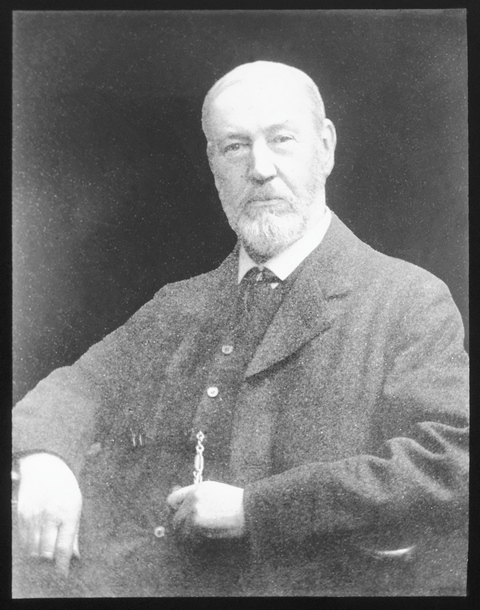
T H Thomas from Society Archives Thomas Henry Thomas was born at the Baptist College, Pontypool on 31st March 1839. His father was Dr Thomas Thomas (1836 - 1877), President of the Baptist College and his mother Mary David, a member of a 'well known and highly respected Cardiff family'. He was initially home educated by his father but later was sent to the Dr Bompas Academy in Fishponds, Bristol and then on to the Bristol School of Art where he won a national medal for design. He moved to Carey's School in Bloomsbury, London in 1858 before travelling to Paris, Rome and other parts of Italy in 1863 as the paid companion to the son of Charles Herbert James, the Liberal MP for Merthyr Boroughs. (note Charles Herbert was uncle to Charles Henry James, 29th President) In 1864 he returned to London and settled down as a painter, working mainly on portraiture, design and book illustrations as well as lecturing on art subjects in London and the provinces. He was the special artist for The Graphic, a weekly illustrated newspaper first published in 1869 and also The Daily Graphic, which began publication in 1889. In 1884 he went as the Graphic's special artist with the British Association to Canada where he made an extended tour from Montreal to the Rocky Mountains and Yellowstone National Park. In 1866 he married, Ellen Sully, the daughter of a Bridgewater ship owner, who died in 1879 following a still birth. In 1881 he inherited his father's house at 45, The Walk, Roath, Cardiff and moved to Wales. He joined the Cardiff Naturalists' Society in 1879 becoming President of the Society in 1888-89 and President of the Biological and Microscopical (later to become the Biological and Geological) Section from 1890 until 1906. He also served on the committee of the Archaeological Section. 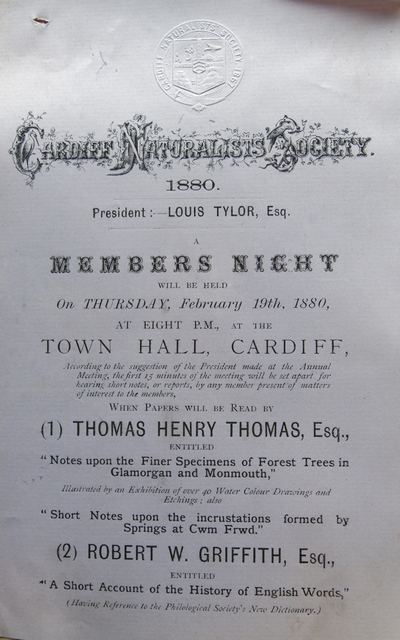
T H Thomas lecture poster In September 1878 he found a set of fossil footprints in a slab of Triassic-age sandstone at Newton Nottage, Porthcawl. Their bird-like shape was noted but Professor William Johnson Sollas (then at Bristol University) correctly identified them as having been made by a dinosaur in 1879 and named them in Thomas' honour, Brontozoum thomasii. These were the first dinosaur footprints found in Wales. The slab was almost six feet square and weighed about 3 tons and Charles Tanfield Vachell, the Hon Secretary of the Cardiff Naturalists' Society at the time, persuaded the President, Col. T. Picton Turbeville, to purchase the slab and have it transported to Cardiff where it was cut. It can be seen today in the Evolution of Wales display in Amgueddfa Cymru-National Museum Wales. You can see his initials on the cut version of the slab in the picture below 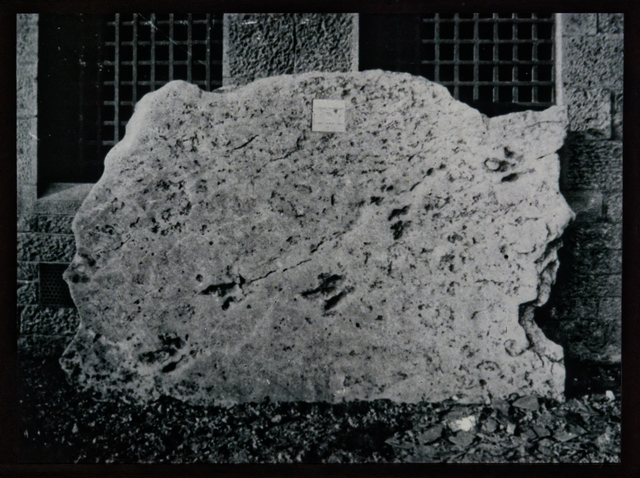
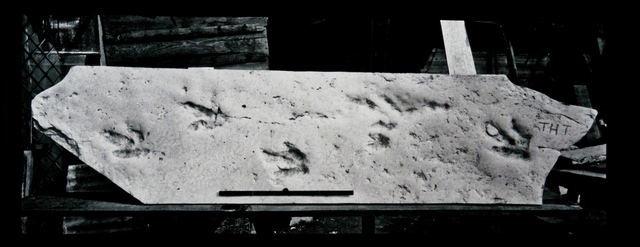
Brontozoum thomasii identified by T H Thomas, and named after him, before and after slab cutting In 1880 Thomas was commissioned to draw examples of trees in Monmouthshire and Glamorgan for the publication Silva Silurica and was part of a group of naturalists who helped John Storrie with his research for the first Flora of Cardiff that was published by the Cardiff Naturalists' Society in 1886. In 1881 Thomas became Vice-President of the newly formed South Wales Art Society. He was also a Fellow of the Royal Cambrian Academy of Arts. He undertook a lot of research on Welsh art and artists but never published this although he made his research findings available to others. He made many donations to the Municipal and later National Museums' collections from 1879 until his death. As well as art Thomas was also keen to see 'bygones' collected, so much so that by 1898 the museum's holdings of these items became known as the T.H.Thomas Collection. in 1884 he is listed as a director of the Fine Art Loan Exhibition in Aid of the Fund for Establishing the Royal Cambrian Academy of Arts in Cardiff. he is listed in the catalogue as providing a number of items for the exhibition From the Catalogue (of which there is an excellent scanned copy online ) The Exhibition has been promoted by the Cardiff Scheme Committee of the Royal Cambrian Academy of Arts, and the profits derived from it are to he devoted to the purposes of the permanent establishment of the Academy in Cardiff. On the settlement of the institution in Cardiff it is the intention of the Council to hold Annual Exhibitions of Works of Fine Art, for the reception of which Galleries will be erected, with Studios, Lecture Hall, and other requisites for an Art School, the tuition in which, given by members of the Academy, will be free to all students passing a certain standard entrance examination. T H Thomas from Society Archives The Academy, although instituted for the encouragement of the Arts of Painting, Sculpture, and Architecture, will also, in so far as is practicable, give encouragement to the Art of Music at its Annual Exhibitions. The Royal Cambrian Academy. having for its object the increase of the feeling for Fine Art in Wales, confidently hopes for the generous aid of all interested in culture in the Principality. In 1886 he moved to Dublin where he stayed for over a year preparing, with Sollas, the illustrations for Vol. 25 of the Challenger Expedition reports (on sponges), which were drawn directly from the microscope and in the end amounted to 44 lithographic plates. In July 1886 he was the artist on an expedition to examine the ocean fauna off the south-west coast of Ireland under Prof. Alfred Cort Haddon, then Professor of Zoology at the Royal College of Science in Dublin. In 1889 went on a field trip to the volcanoes of Sicily and the Naples district with Sollas and members of the Geologists' Association on a meeting to commemorate the centenary of the priest-scientist, Lazzaro Spallanzani's visit to the area. 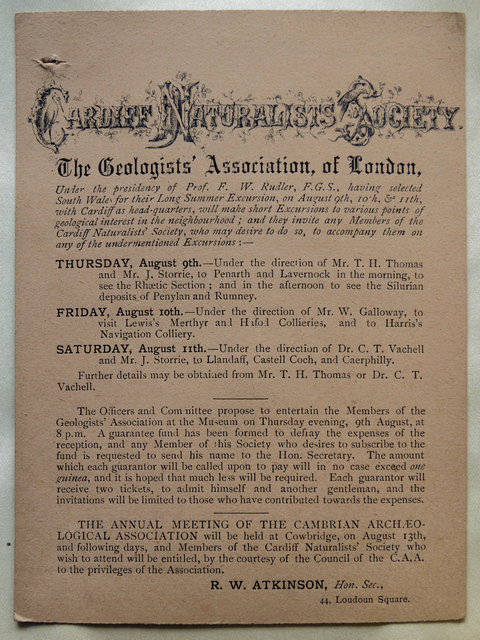
T H Thomas field meeting poster In 1890 he visited Grassholm with three other members of the Cardiff Naturalists' Society, Joshua John (JJ)Neale, Thomas William Proger and Henry West, to see the gannets. Here they witnessed the destruction of the sea birds by a naval company from HMS Sir Richard Fletcher. They were appalled by the destruction and Thomas sketched the scenes which later appeared in the Daily Graphic and Animal World. This was written up in Volume XXII Part II of the transactions
Questions were asked in Parliament and eventually the sailors were prosecuted by the RSPCA and fined. Following on from this Thomas was elected Chairman of a committee to consider the best means of protecting wild bird eggs at the British Association for the Advancement of Science in Cardiff and 1891 and again the following year when the committee was reappointed at the Edinburgh meeting. This lead to further bird protection Acts of Parliament in 1894 and 1896. In order to aid the protection of the birds on the Welsh offshore islands as well as to aid research, J.J. Neale took over the lease of Grassholm and Skomer. 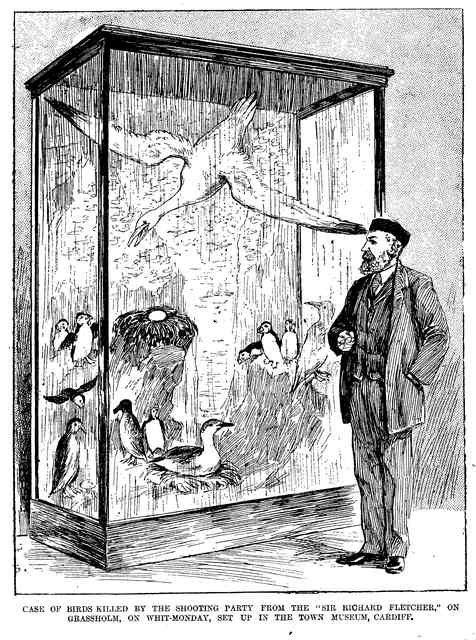
T H Thomas in front of case of shot birds A fuller writeup with more pictures and information is given on this page The Sad Tale of the Grassholm Gannetry he continued throughout this time his close association with the planning for and development of the National Museum of Wales, and frequently gave talks on subjects related to this to the Society and other groups 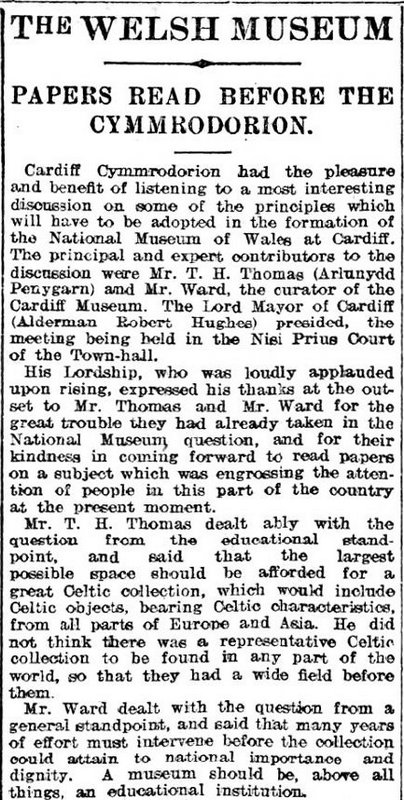
T H Thomas speaking to the Cardiff Cymmrodorion, Weekly Mail 11th November 1905 in 1909 Thomas gave extensive evidence to the Royal Commission on Ancient Monuments
T H Thomas Royal Commission Evidence Link to complete document Thomas is rightly regarded as one of the founding fathers of the National Museum of Wales. He had advocated for such an institution at the Pontypridd Eisteddfod in 1894 and fought for it to be located in Cardiff. After the National Museum was founded in 1907 Thomas represented the Council of the University College Cardiff at the first meeting of the Museum's Court of Governors and also sat on Museum's Council, General Purposes and Finance Building Committees. He pushed for dragons as well as lions to be placed on the building but never lived to see it completed. Bust of T H Thomas in marble created by William Goscombe John in 1902 and begueathed by Thomas in 1924 Thomas died in his sleep following a heart attack on 5th July 1915 and is buried in the non-conformist section of Cathays Cemetery along with his wife, Ellen. Their headstone is in the form of a Celtic cross. This picture taken on a CNS walk to the cemetary has members in the background looking at wildlife in this peaceful location 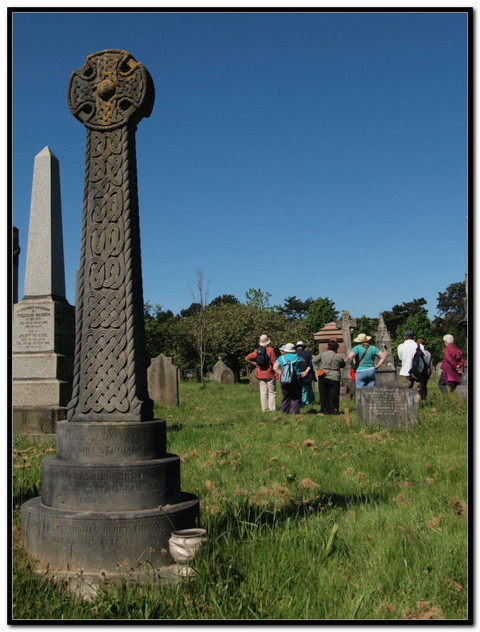
T H Thomas Gravestone These pages are about our history and are celebrating the people who developed our Society over the last 150 years. You can read more about that using the links below Back to the 150th Anniversary index Before this... Principal John Viriamu Jones (1856-1901) 15th President Next Up... William Ronnfeldt (1837-1919) 17th President
See our Full list of Presidents If you want to read about the ways we study the wildlife and environment of the Cardiff area and its surroundings, and about the talks we have about the wildlife of the world, and find the programme of talks, walks and other events that we do then please take a look at our main website, our blog and our facebook and twitter feeds for up to date news |
